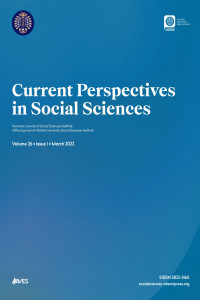Yöresel Mutfak Marka Değeri Algısının Destinasyon Farkındalığı ve Destinasyon Sadakati Üzerindeki Etkisi
Yöresel Mutfak Marka Değeri, Destinasyon Farkındalığı, Destinasyon Sadakati, Mudurnu
___
- Hall, C. M., & R. Mitchell (2000). “Wine Tourism in the Mediterranean: a Tool for Restructuring and Development”, Thunderbird International Busi¬ness Rewiew, 42(4), 445-465.
- Hall, C. M., R. Mitchell & L. Sharples. (2003). “Consuming Place: The Rool of Food, Wine and Tourism in Regional Devolepment”. Hall, C. M., Sharples, L., Mitchell, R., Macionis, N., ve Cambourne, B. (Ed.). Food Tourism Around the World Development, Management and Markets içinde. New York: Routledge.
- Harrington, R. J. & Ottenbacher, M. C. (2010). “Culinary Tourism - A Case Study of the Gastronomic Capital”. Journal of Culinary Science & Technology, 8(1), 14-32.
- Horng, Jeou-Shyan, Liu, Chih-Hsing, Chou, Hsin-Yu & Tsai, Chang-Yen (2012). “Understanding the Impact of Culinary Brand Equity and Destination Familiarity on Travel Intentions”. Tourism Management, 33(4), 815-824.
- Jacoby, J.W., & Chestnut, R.W. (1978). Brand Loyalty Measurement and Management. New York: Wiley.
- Kandampully, J., & Suhartanto, D. (2000). “Customer Loyalty in the Hotel Industry: the Role of Customer Satisfaction and Image”. International Journal Of Contemporary Hospitality Management, 12(6), 346-351.
- Keller, K. L. (1993). “Conceptualizing, Measuring, and Managing Customer-Based Brand Equity”. Journal of Marketing. 57(1), 1-22.
- Keller, K. L. (2003). Strategic Branding Management: Building, Measuring and Managing Brand Equity, N.J.:Pearson Education Inc.
- Kim, Y. G. & Eves, A. (2012). “Construction and Validation of A Scale to Measure Tourist Motivation to Consume Local Food”. Tourism Management, 33(6), 1458-1467.
- Kim, Y. G. & Eves, A. ve Scarles, C. (2009). “Building A Model of Local Food Consumption on Trips and Holidays: A Grounded Theory Approach”. International Journal of Hospitality Management, 28(3), 423-431.
- Aaker, D. A. (1991). Managing Brand Equity. New York: The Free Press.
- Kivela, J. & Crotts, J. C. (2005). “Gastronomy Tourism”. Journal of Culinary Scien-ce & Technology, 4(2-3), 39-55.
- Lewis, R. C., & Chambers R. E. (1989). Marketing Leadership in Hospitality. New York: Van NostrandRemhold.
- McKercher, B. & Wong, D. Y. Y. (2004). "Understanding Tourism Behavior: Examining the Combined Effects of Prior Visitation History and Destination Status", Journal of Travel Research, 43, 171-179.
- Oppermann, M.. (2000). "Tourism Destination Loyalty", Journal of Travel Research, 39(1), 78-84.
- Renko, S., N. Renko & T. Polonijo (2010). “Understanding the Role of Food in Rural Tourism Development in a Recovering Economy”, Journal of Food Products Marketing, 16(3), 309-324.
- Santich, B. (2004). “The Study of Gastronomy and Its Relevance to Hospitality Education and Training”. International Journal of Hospitality Management, 23(1), 15-24.
- Seo, S., Yun, N. & Kim, O. Y. (2014). “Destination Food Image and Inten¬tion to Eat Destination Foods: A View From Korea”. Current Issues in Tourism, 1-22.
- Şengül, S. ve Türkay, O. (2016). “Yöresel Mutfak Unsurlarının Turizm Destinasyonu Seçimindeki Rolü (Mudurnu Örneği)”. Uluslararası Yönetim İktisat ve İşletme Dergisi. 12(29), 63-87.
- Valkenburg, P. M., & Buijzen, M. (2005). “Identifying Determinants of Young Children's Brand Awareness: Television, Parents, and Peers”. Journal of Applied Developmental Psychology. 26(4), 456-468.
- Yoo, B., & Donthu, N. (2001). “Developing and Validating a Multidimensional Consumer-Based Brand Equity Scale”. Journal of Business Research, 52(1), 1-14.
- Amira F. (2009). “The Role of Local Food in Maldives Tourism: A Focus on Promotion and Economic Development”. New Zealand Tourism Research Institute.
- Yoon, Y. & Uysal, M. (2005). “An Examination of the Effects of Motivation and Satisfaction on Destination Loyalty: A Structural Model”. Tourism Management. 26, 45-56.
- Boo, S., Busser, J. & Baloğlu, S. (2009). “A Model of Customer- Based Brand Equity and Its Application to Multiple Des¬tinations”. Tourism Management, 30 (1), 219-231.
- Chen, J. S. & Gürsoy, D. (2001). "An Investigation of Tourists' Destination Loyalty and Preferences". International Journal Contemporary Hospitality Management, 13(2), 79-85.
- Çetinsöz, B. C. ve Artuğer, S. (2013). “Antalya İli’nin Marka Değerinin Ölçülmesine Yönelik Bir Araştırma”, Anatolia: Turizm Araştırmaları Dergisi. 24(2), 200-210.
- Dick, A. & Basu, K. (1994). “Customer Loyalty: Towards An Integrated Conceptual Framework”. Journal of The Academy of Marketing Science, 22 (2), 99- 113.
- Fesenmaier, D.,Vogt, C. A. & Stewart W. P. (1993). “Investigating the Influence of Welcome Center Information on Travel Behavior”. Journal of Travel Research, 31, 47-51.
- Gartner, C. W. & Ruzzier, K. M. (2010). “Tourism Destination Brande Quity Dimensions: Renewal Versusrepeat Market”. Journal of Travel Research, 50(5), 471-481.
- Guan, J. & D. L. Jones (2015) “The Contribution of Local Cuisine to Destination Attractiveness: An Analysis Involving Chinese Tourists' Heterogeneous Preferences”. Asia Pacific Journal of Tourism Research, 20(4), 416-434.
- Başlangıç: 2003
- Yayıncı: Atatürk Üniversitesi
Antalya Müzesi’nden Bir Grup Kandil Üzerine Gözlemler
Muhasebe Meslek Mensuplarında Tükenmişlik Sendromu: TRA1 ve TRA2 Bölgelerinde Bir Araştırma
Sentagmatik ve Paradigmatik İlişkiler Bağlamında Türkçe Dil Birimlerine Metodolojik Bakış
Kara Çelebi-Zâde Abdülaziz Efendi’nin Tarihçiliği ile Devlet Adamlarına ve Olaylara Bakışı
Gerede İlçesinde Nüfusun Gelişimi
İlköğretim Din Kültürü ve Ahlak Bilgisi Öğretim Programında Saygı Değeri
Kişisel Değerlerin Psikolojik Sermaye ve İş Tatmini İlişkisinde Moderatör Etkisi
A Gender Study or Shift Of Balance in David Mamet’s Oleanna
Konrad Bayer’in “Altıncı His” Romanında İroni
Film-Roman Karşılaştırması: Jurek Becker'in Sinemaya Uyarlanan “Yalancı Jakob” Adlı Romanı
